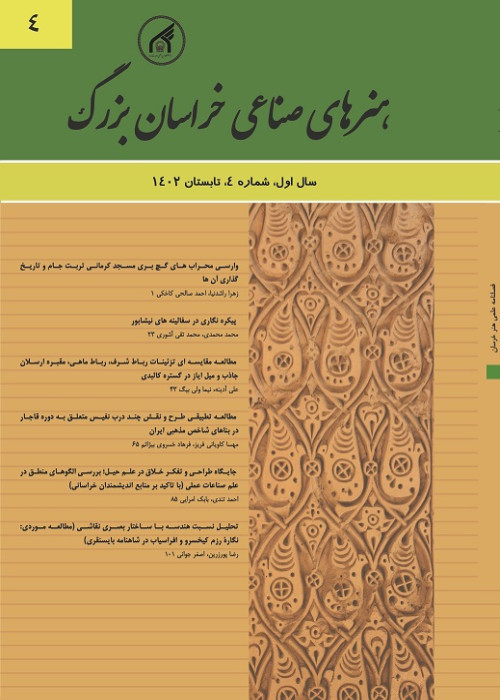Brick ornaments and tilework of Aliabad Keshmar tower
Author(s):
Article Type:
Research/Original Article (بدون رتبه معتبر)
Abstract:
Brick ornaments and decorations have been gradually prevelant since the first centuries of Islam, and was then flourished in Seljuk period. In combination with tiles and other endemic materials has found its way to embellish religious monuments and also the other forms of Iranian architecture until the current era. One of the remaining monuments since early eighth century AH is Aliabad tower located in Khorasan province, which is grandstanding by the utilization of various brick and tile ornaments in the middle of desert of Iran. Richness of decorative designs and forms on the interior and exterior body, walls, ceiling and also harmony between the building and decorations can be pointed out as main qualities of this particular building. Collecting data for this study was carried out through library studies, especially field studies and based on analytical method in which the tower’s brick ornaments and tiling have been studied for the purpose of introducing the building, recognizing types of brick bonding, tilework, and plaster art, variety of classified brick layouts and also all sorts of botanical designs. The data has shown that the structure and architecture methods of Keshmar tower have been adopted from previous towers and from the combination of their segments which is the evolved example of the similar category in early eighth century AH. The main parts of exterior decoration are brick bonding in rows as well as combinations of brick and tile in many kinds of patterns such as rows of nine, seven, five and three, located on dodecagon frames, half cylindrical crests and triangular prisms. The entrance, colonnades, balusters and the base of the conical cupolas are all embellished with different types of “Rag Chin”, “Khofteh-Rasteh”, “Khofteh-Rasteh Kalouk-Band” and dual “Kalouk-Band” (which are types of bonding and brick working). All of interior surfaces are designed with Muqarnas and Stucco (plaster). The tiles used for decoration are patterned with arabesque and angelica designs and colored as turquoise or azure.
Keywords:
Language:
Persian
Published:
Journal of Handicrafts of Great Khorasan, Volume:1 Issue: 2, 2023
Pages:
75 to 92
https://magiran.com/p2644822
دانلود و مطالعه متن این مقاله با یکی از روشهای زیر امکان پذیر است:
اشتراک شخصی
با عضویت و پرداخت آنلاین حق اشتراک یکساله به مبلغ 1,390,000ريال میتوانید 70 عنوان مطلب دانلود کنید!
اشتراک سازمانی
به کتابخانه دانشگاه یا محل کار خود پیشنهاد کنید تا اشتراک سازمانی این پایگاه را برای دسترسی نامحدود همه کاربران به متن مطالب تهیه نمایند!
توجه!
- حق عضویت دریافتی صرف حمایت از نشریات عضو و نگهداری، تکمیل و توسعه مگیران میشود.
- پرداخت حق اشتراک و دانلود مقالات اجازه بازنشر آن در سایر رسانههای چاپی و دیجیتال را به کاربر نمیدهد.
In order to view content subscription is required
Personal subscription
Subscribe magiran.com for 70 € euros via PayPal and download 70 articles during a year.
Organization subscription
Please contact us to subscribe your university or library for unlimited access!


